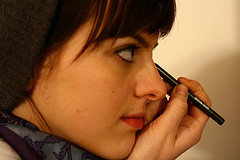
 It’s hard enough being a teenager without throwing cancer into the mix. There are all the cliques at school, worrying about your wardrobe, trying to fit in, after-school activities, and somewhere in there, hoping to get good grades to make it into college. Dealing with cancer can definitely put you into overload, and then trying to still look good…is it even possible? Especially with dry skin, redness or acne?
It’s hard enough being a teenager without throwing cancer into the mix. There are all the cliques at school, worrying about your wardrobe, trying to fit in, after-school activities, and somewhere in there, hoping to get good grades to make it into college. Dealing with cancer can definitely put you into overload, and then trying to still look good…is it even possible? Especially with dry skin, redness or acne?
Cancer definitely changes your face. It may be hard to recognize yourself in the mirror on some mornings. Following are some tips to help you camouflage problem areas without overdoing it, or putting a huge dent in your already crammed schedule. Of course, remember to always use non-toxic, natural products!
1. Gently cleanse. Throw away those harsh, exfoliating cleansers (especially the acne ones) and go for a gentler, more moisturizing, non-toxic, safe brand. Go easy on your skin, rubbing gently with your fingers, and rinse with tepid (not hot) water. If you use a toner, make sure it is alcohol-free. Toners with alcohol can further dehydrate and irritate sensitive skin.
2. Hydration, hydration! Cancer skin is terribly dry and fragile, so hydrate inside and out. Drink lots of water through the day, and apply toxic-free, preferably organic moisturizer to your skin at least twice a day. Don’t forget the physical sunscreen, too, as your skin will be more photosensitive. (A formula with zinc oxide is the safest.)
3. Foundation. If your skin is fairly smooth and suffering only from dryness or a bit of off-color, choose liquid foundation for its moisturizing and sheer-looking qualities. If you’re fighting with acne or redness, go for a cream or mousse that will give you a bit more coverage but not dry you out. (Skip the powder foundations for now.) Use a clean sponge (discard after each use to avoid infection) and sweep over your entire face. Don’t forget to blend, blend, blend, especially along the jawline and hairline.
4. Concealer. For problem areas like blemishes or dark undereye circles, use a liquid concealer after foundation to spot-cover. If you’ve got darkness or redness on your cheeks, you may want to try cream concealer on those areas before you apply foundation. Pat and blend with your fingertip.
5. Bronzer. If your skin is looking a little dull (which tends to happen with cancer treatments), brush a shimmering bronzer on the nose, chin, and forehead. Save the cheeks for blush.
6. Blush. Nothing livens you up like a little color in the cheeks. Again, creams will be less drying, so try them over your foundation on the apples of your cheeks. Use a clean sponge to apply to avoid risk of contracting germs. A little goes a long way, so don’t overdo. The effect should look like you’ve got a little blood rushing to your cheeks-like you have just finished a workout. (Powders are okay too, just sweep lightly on with a large brush-not the one in the container!)
7. Eyeliner. Especially if you’re suffering from loss of eyelashes, you can’t go without eyeliner. If you’re in a hurry, choose a crayon over liquid. (Crayons are more forgiving than liquids if you make a mistake, and more moisturizing than pencils.) Draw along the lash line, and smudge a little to fill in any empty spaces between the lashes. To help eyes look open and lively, only line the outer half of your lower lid.
8. Mascara. Be careful, here. A little mascara will help fill in sparse eyelashes, but if you use a harsh or waterproof formula, you risk rubbing more eyelashes away when you take it off. Don’t use an eyelash curler (unless it’s a special occasion), as it can pull out fragile lashes. If you really need curl, heat a spoon and touch it to the ends of your lashes. (Be careful!) Apply mascara only to the tips of lashes.
9. Eyebrows. Again, you may be losing a few hairs here, so use an eyebrow pencil or matching shadow color to fill in, then brush hairs in place with an eyebrow brush or a toothbrush.
10. Lips. Your mouth needs a lot of extra moisture through treatments, so keep the organic lip balm with you and hide the matte, long-wearing lipsticks, as they can be drying. Choose moisturizing formulas, or better yet, go for a simple lip gloss.
Have you had cancer as a teen? Do you have tips for applying makeup? Let us know.
Photo courtesy Crustina via Flickr.com.

